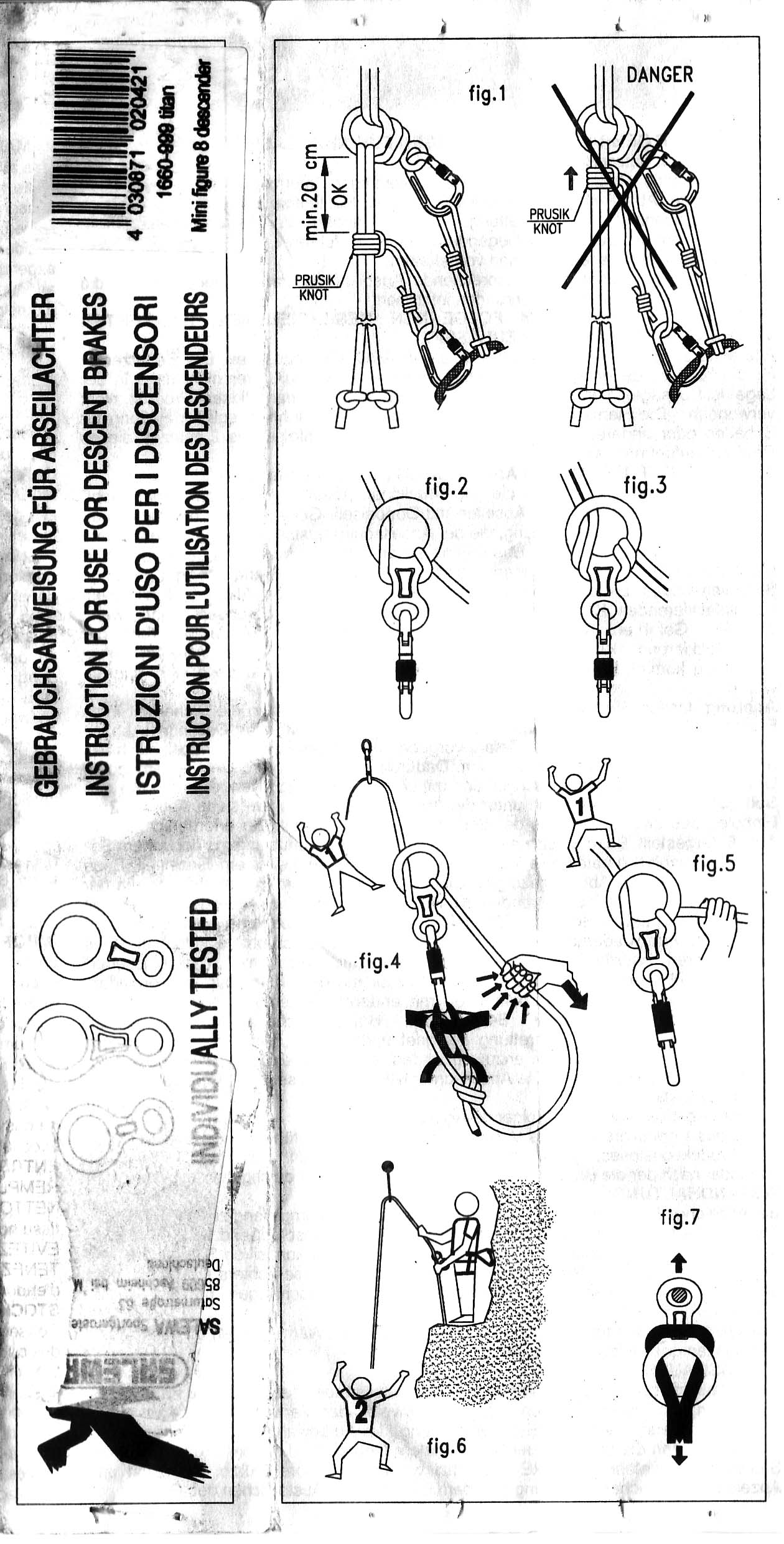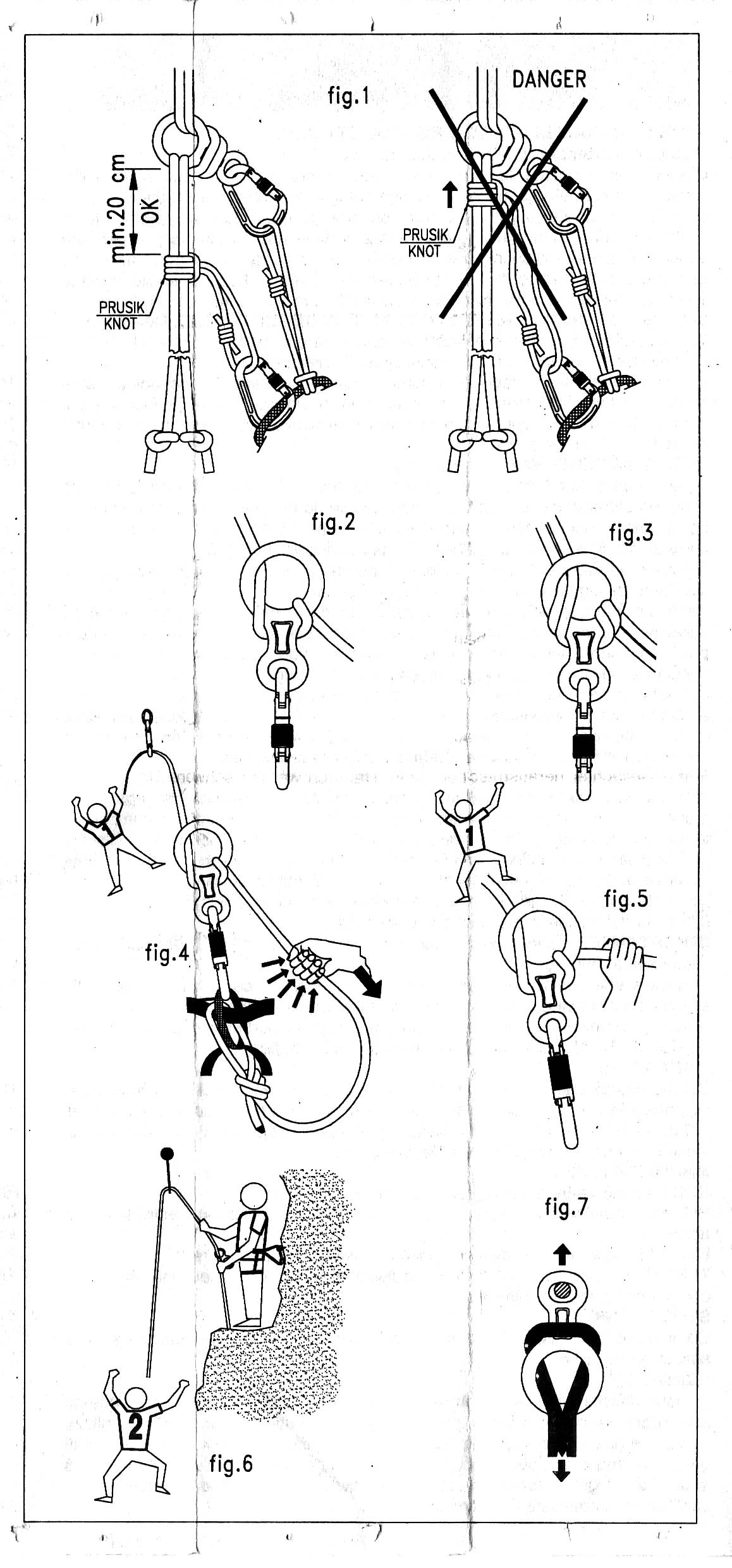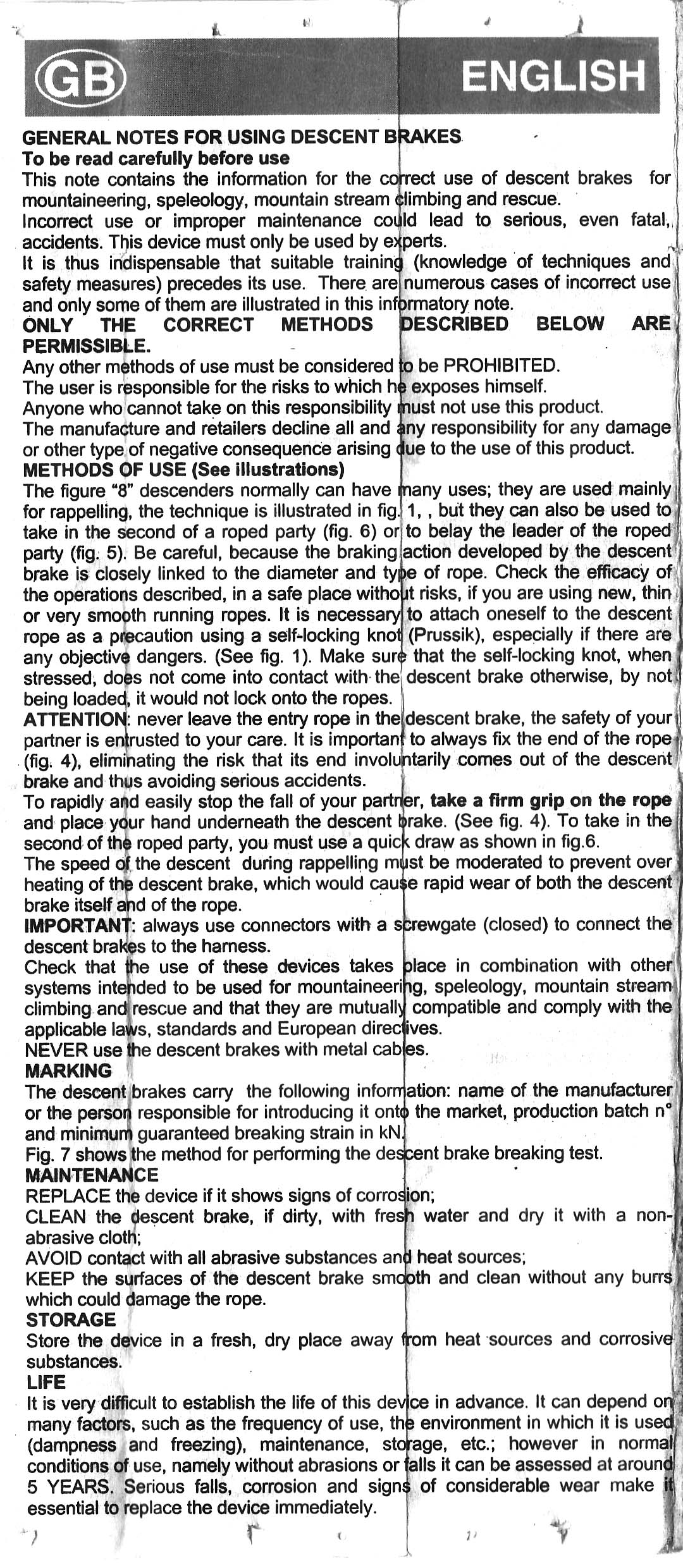
Salewa
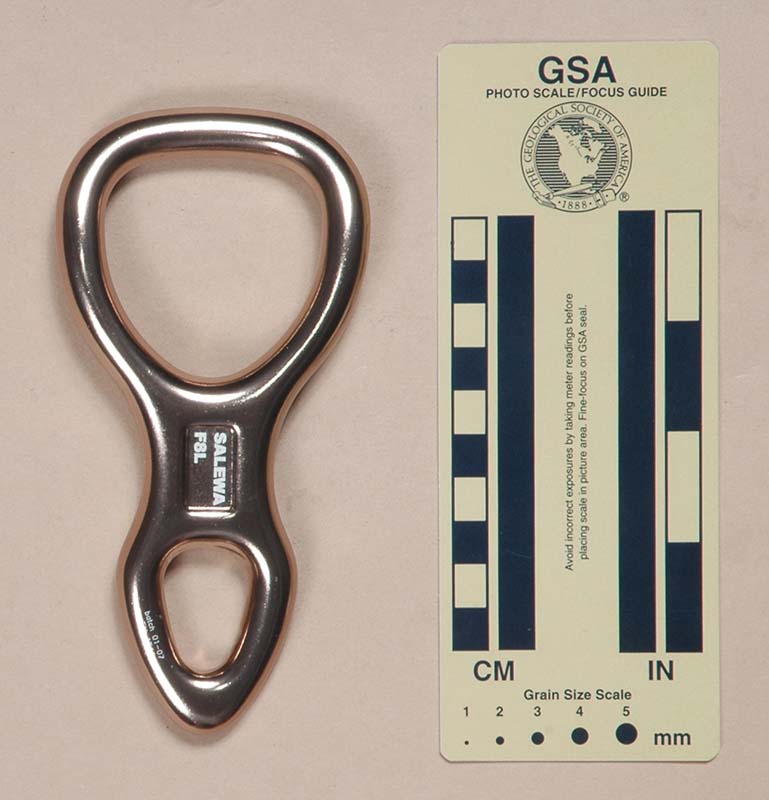
Salewa G2, Large (Model F8L)
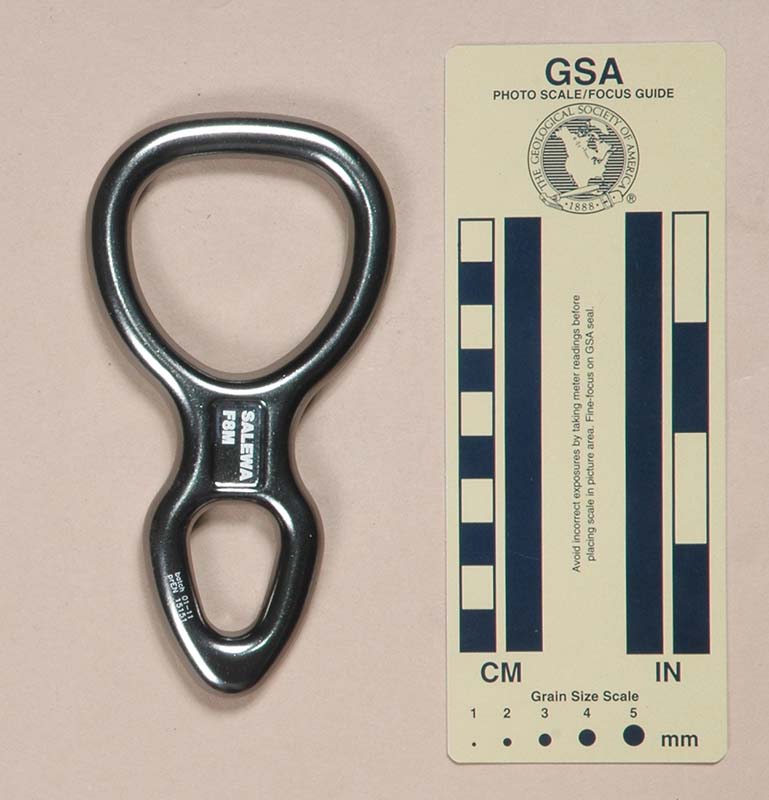
Salewa G2, Medium (Model F8M)
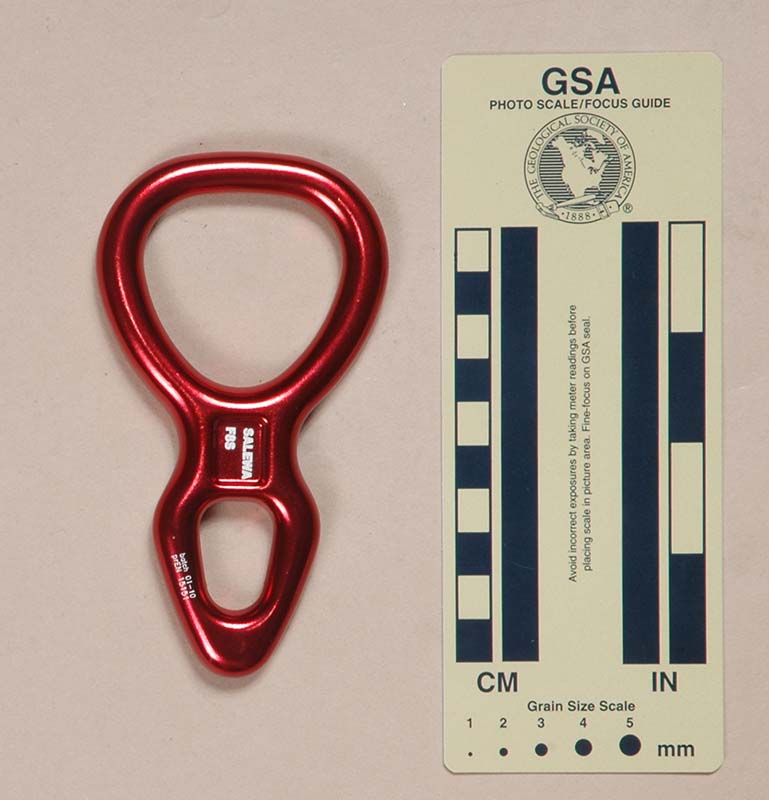
Salewa G2, Small (Model F8S)
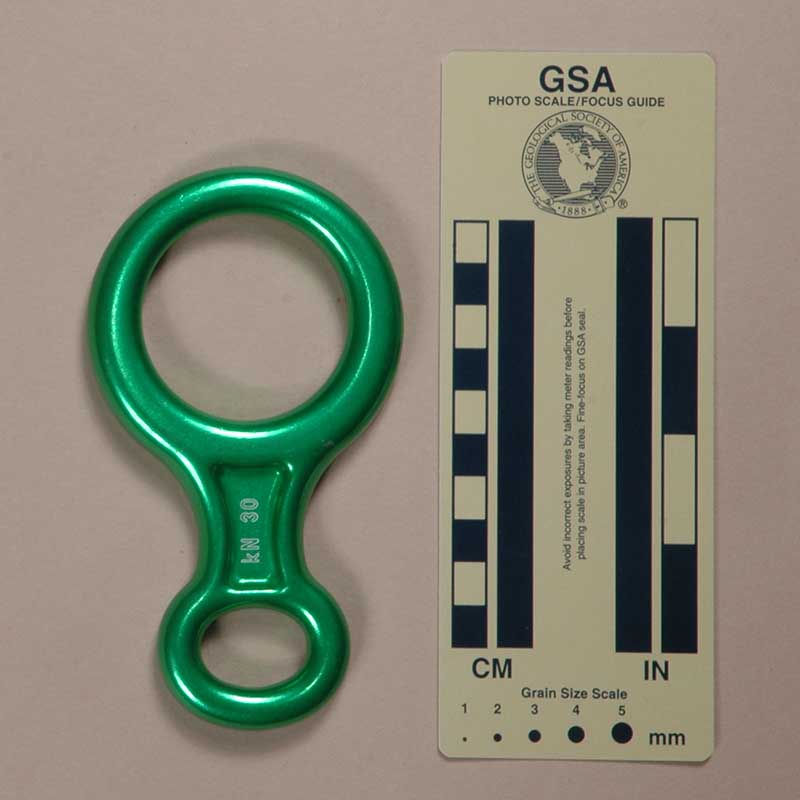
Midi, Version A
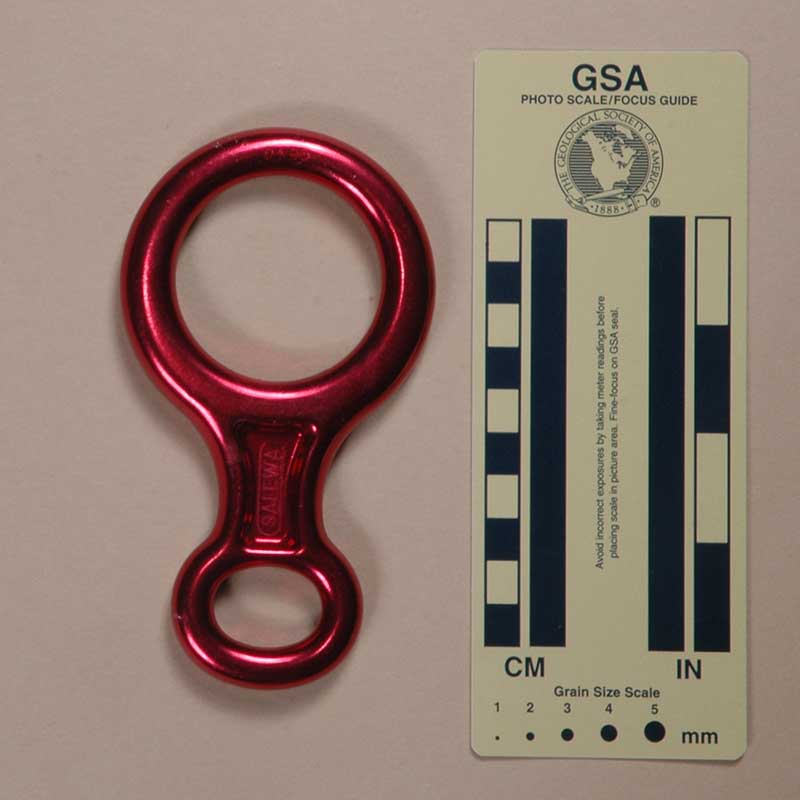
Midi, Version B
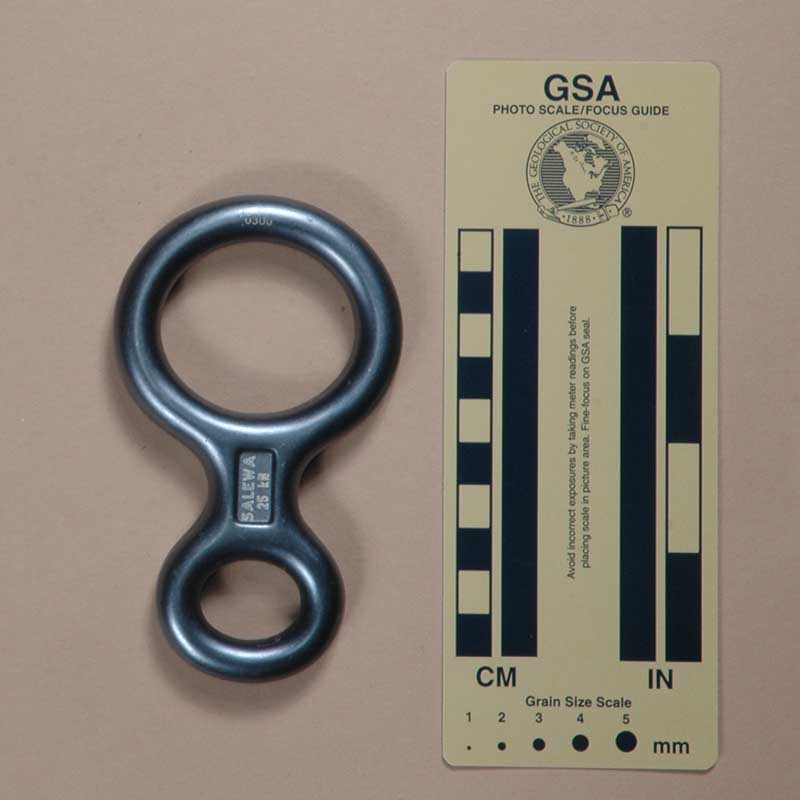
Mini
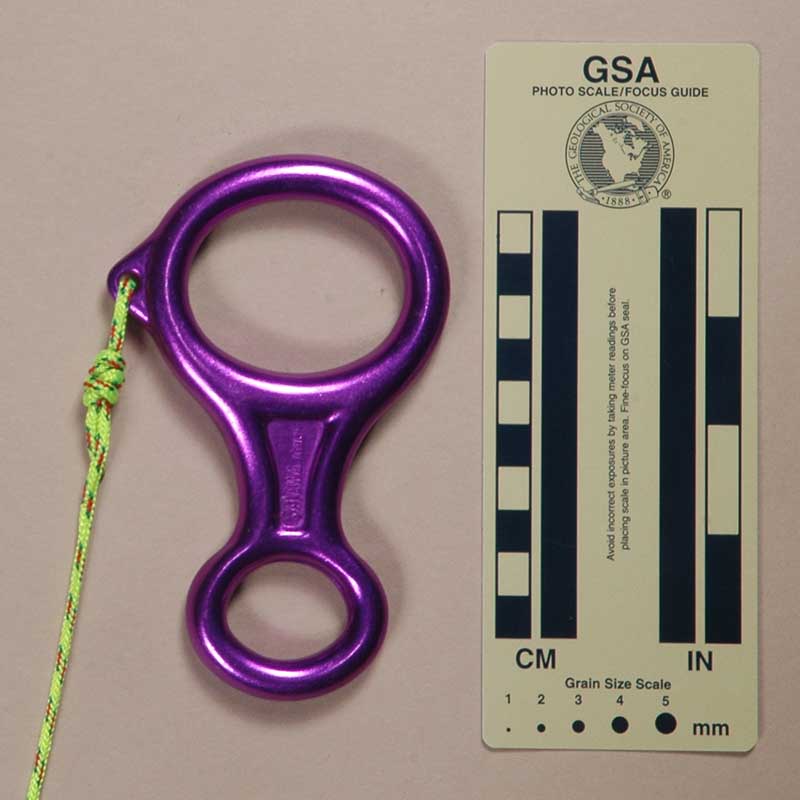
Version A
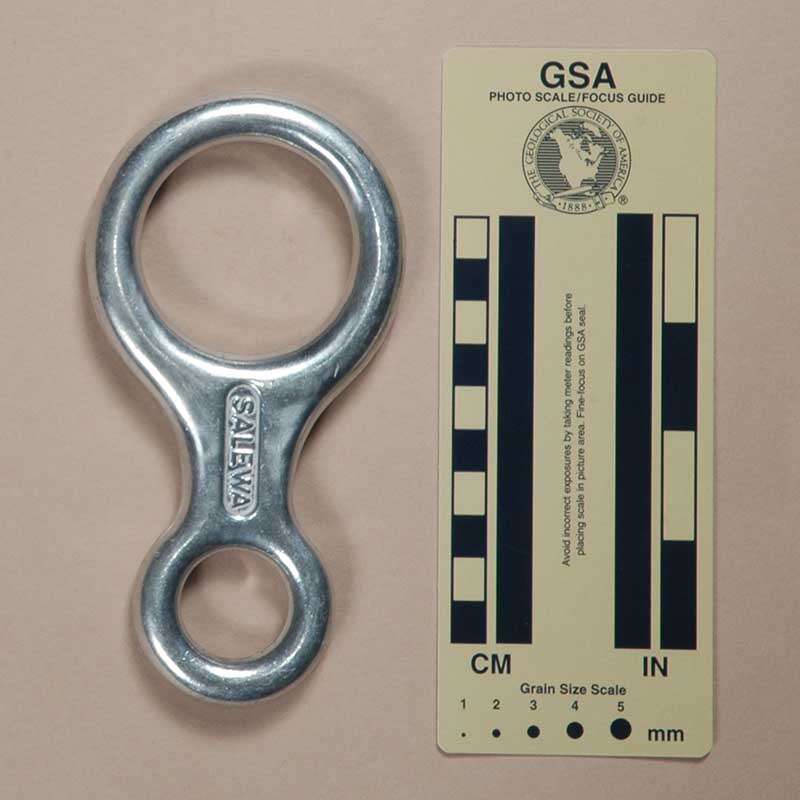
Version B
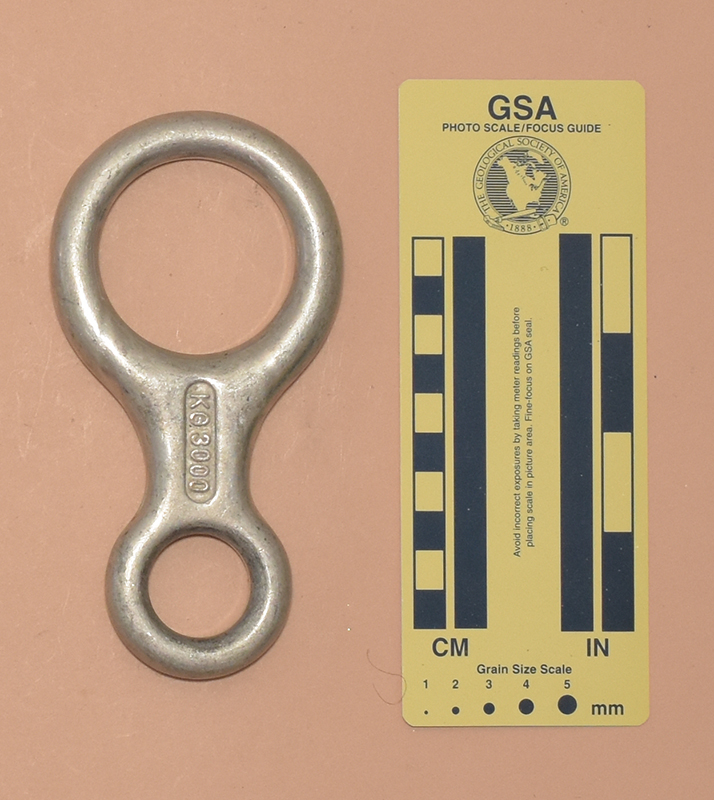
Version C
[ Top
| Salewa G2, Medium (Model F8M)
| Salewa G2, Small (Model F8S)
| Midi, Version A
| Midi, Version B
| Mini
| Version A
| Version B
| Version C
| Return to Figure Eights
]
Salewa G2, Large (Model F8L)
(#1365)
Technical Details
I acquired my Salewa G2, Large (Model F8L) from TrekkInn in 2012.
The G2 F8L is forged from aluminum alloy and then soft anodized. Mine is 145 mm. tall, 72 mm. wide, and 18 mm. thick. The rope hole is 51 mm. high and 50 mm. wide. The top center thickness is 11 mm, and the top is bent backward 11 mm. The shaft length and width are 39 mm. and 30 mm., respectively. The eye measures 28 mm. by 19 mm. My eight weighs 113 g.
The front of this eight is printed with "Salewa," "F8L," "batch 01-07," and "prEN 15151." The rear has "KN 30" in raised letters.
The Salewa G2 F8L is another example of a "Flat
Top" aluminum eight. The slight bend at the top allows the eight to be used in two different friction configurations, but the difference is marginal.
The eye is too narrow to accept two full size locking carabiners, but it is tall enough to use as a belay slot.
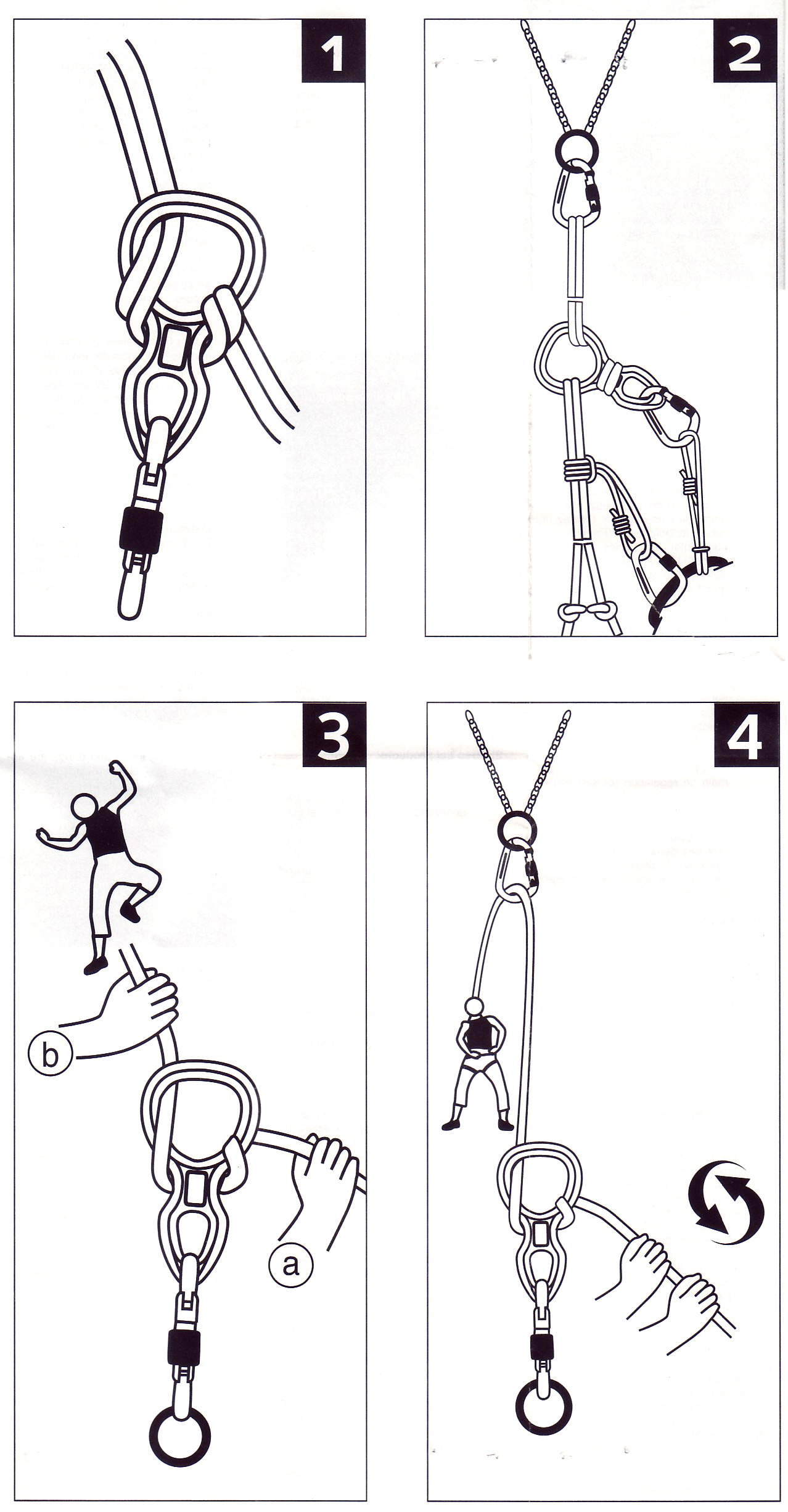 |
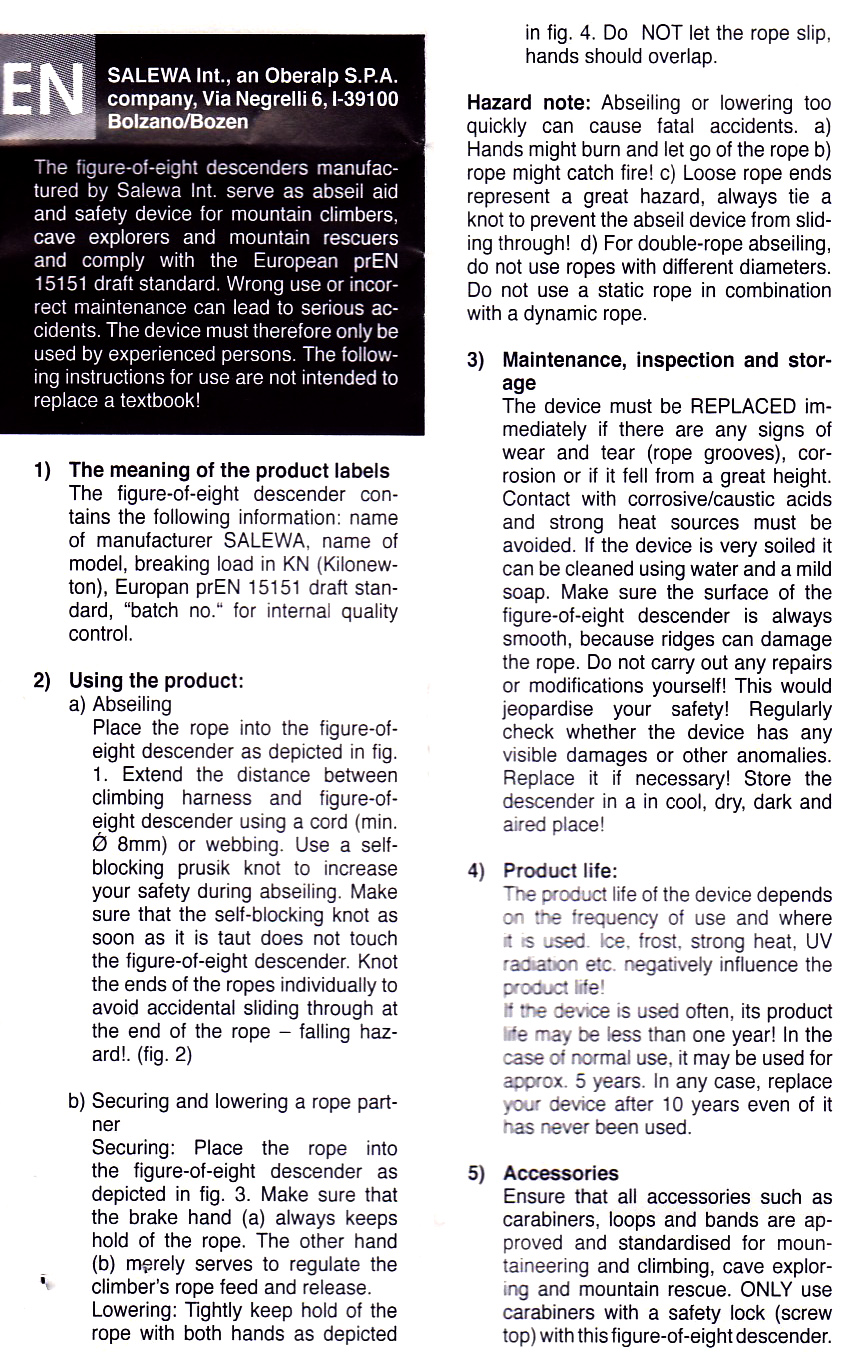 |
[ Top
| Salewa G2, Large (Model F8L)
| Salewa G2, Small (Model F8S)
| Midi, Version A
| Midi, Version B
| Mini
| Version A
| Version B
| Version C
| Return to Figure Eights
]
Salewa G2, Medium
(Model F8M)
(#1337)
Technical Details
I acquired my Salewa G2, Medium from TrekkInn in 2012.
The Salewa G2, Medium is forged from aluminum alloy and then soft anodized. Mine is 136 mm. tall, 72 mm. wide, and 13 mm. thick. The rope hole is 49 mm. high and 50 mm. wide. The top center thickness is 11 mm. The shaft length and width are 30 mm. and 27 mm., respectively. The eye measures 29 mm. by 20 mm. My eight weighs 102 g.
The front of this eight is printed with "Salewa," "F8M," "batch 01-11," and "prEN 15151." The rear has "KN 30" in raised letters.
The Salewa G2 F8M is another example of a "Flat
Top" aluminum eight.
The eye is too narrow to accept two full size locking carabiners, but it is tall enough to use as a belay slot.
[ Top
| Salewa G2, Large (Model F8L)
| Salewa G2, Medium (Model F8M)
| Midi, Version A
| Midi, Version B
| Mini
| Version A
| Version B
| Version C
| Return to Figure Eights
]
Salewa G2, Small
(Model F8S)
(#1336)
Technical Details
I acquired my Salewa G2, Small (Model F8S) from TrekkInn in 2012.
The Salewa G2, Small (Model F8S) is forged from aluminum alloy and then soft anodized. Mine is 121 mm. tall, 68 mm. wide, and 13 mm. thick. The rope hole is 45 mm. high and 45 mm. wide. The top center thickness is 9 mm. The shaft length and width are 26 mm. and 28 mm., respectively. The eye measures 25 mm. by 17 mm. My eight weighs 80 g.
The front of this eight is printed with "Salewa," "F8S," "batch 01-10," and "prEN 15151." The rear has "KN 30" in raised letters.
The Salewa G2 F8S is another example of a "Flat
Top" aluminum eight.
The eye is too narrow to accept two full size locking carabiners, but it is tall enough to use as a belay slot.
[ Top
| Salewa G2, Large (Model F8L)
| Salewa G2, Medium (Model F8M)
| Salewa G2, Small (Model F8S)
| Midi, Version B
| Mini
| Version A
| Version B
| Version C
| Return to Figure Eights
]
Midi, Version A
(#919)
Technical Details
I acquired this eight from Barrabés.com in Spain in
2003.
The Salewa Midi, Version A is forged from aluminum alloy and then soft
anodized. Mine is 121 mm. tall, 75 mm. wide, and 13 mm
thick. The rope hole is 48 mm. high and 48 mm. wide.
The top center thickness is 11 mm. The shaft length and width
are 44 mm. and 24 mm., respectively. The eye measures
18 mm. by 26 mm. My eight weighs 107 g.
The front of this eight is etched with "kN 30," and
the rear is stamped "0101" (month of manufacture?) near
the top. There are no markings to indicate that this is a Salewa
eight.
The Salewa Midi is a "midi"
size, forged, aluminum eight sharing one of the most common designs of this type. The following eights are quite similar, except for their markings:
Some of these eights are made in Europe, and some in Asia. Some are rebranded eights made by one manufacturer for outside customers and labeled accordingly.
Each of these eights is 131±1 mm. tall and 74±1 mm. wide. Their weights fall in the 105±4 g. range. These are normal manufacturing variations that have no practical significance. Although similar, these eights are not identical, and close inspection will reveal some minor differences in their shapes. None of these affect their performance to any noticeable degree.
The AustriAlpin and C.A.M.P. 928.00/01 appear to have harder anodizing than the others, and may wear better. My experience with the high-quality hard anodizing on CMI eights is that hard anodizing provides considerable protection on clean ropes, but the protection provided against cave mud is limited. In bad conditions the anodizing soon breaks through, and the protection is lost. For this reason, I don't place a lot of value on hard over soft anodizing for caving use, but I prefer hard anodizing for climbing applications.
The rope hole is shorter than normal, so it may provide too much friction on stiff or muddy ropes. Cavers should consider this possibility.
Some caver friends refuse to use figure eights because they twist the rope. I think that concern is absurd for short drops, and eights are short drop devices.
Many climbers think that eights are outdated, and prefer to rappel on belay tubes. I prefer belay tubes for belaying, but belay tubes get very hot when used for rappelling. Eights run much cooler. On any given day, I make my choice about carrying a separate rappel device by considering several factors, and it is not unusual for me to carry an eight if I expect to be rappelling more than a very short distance.
None of these eights have slots for sticht-type belaying, and their oval eyes are not really designed for that purpose. They can be used for "Sticht"
belaying on 9 mm. rope, but the eye is a bit short for optimum
use on 11 mm. rope. Some people will belay with an eight rigged for rappelling, but I don't like that practice since it does not provide the automatic lock and the friction that a sticht does.
Most of these eights have strength markings of 25 or 30 kN. To put this in perspective, the value required by EN 15151-2:2012 is only 7 kn. The excess provides margin for wear.
[ Top
| Salewa G2, Large (Model F8L)
| Salewa G2, Medium (Model F8M)
| Salewa G2, Small (Model F8S)
| Midi, Version A
| Mini
| Version A
| Version B
| Version C
| Return to Figure Eights
]
Midi, Version B
(#1210)
Technical Details
I acquired my Salewa Midi, Version B on eBay from Donna Paxton in 2009.
Version B is forged from aluminum alloy and then soft anodized. Mine is 131 mm. tall, 74 mm. wide, and 13 mm. thick. The rope hole is 48 mm. high and 48 mm. wide. The top center thickness is 11 mm. The shaft length and width are 43 mm. and 24 mm., respectively. The eye measures 19 mm. by 25 mm. My eight weighs 106 g.
One side of the shaft is stamped with "SALEWA" inside an oval, and the other side with "2500 daN." The top front is stamped with "01 95."
Except for the markings, this eight is essentially identical to Version A.
The Salewa Midi is a "midi"
size, forged, aluminum eight sharing one of the most common designs of this type. The following eights are quite similar, except for their markings:
Some of these eights are made in Europe, and some in Asia. Some are rebranded eights made by one manufacturer for outside customers and labeled accordingly.
Each of these eights is 131±1 mm. tall and 74±1 mm. wide. Their weights fall in the 105±4 g. range. These are normal manufacturing variations that have no practical significance. Although similar, these eights are not identical, and close inspection will reveal some minor differences in their shapes. None of these affect their performance to any noticeable degree.
The AustriAlpin and C.A.M.P. 928.00/01 appear to have harder anodizing than the others, and may wear better. My experience with the high-quality hard anodizing on CMI eights is that hard anodizing provides considerable protection on clean ropes, but the protection provided against cave mud is limited. In bad conditions the anodizing soon breaks through, and the protection is lost. For this reason, I don't place a lot of value on hard over soft anodizing for caving use, but I prefer hard anodizing for climbing applications.
The rope hole is shorter than normal, so it may provide too much friction on stiff or muddy ropes. Cavers should consider this possibility.
Some caver friends refuse to use figure eights because they twist the rope. I think that concern is absurd for short drops, and eights are short drop devices.
Many climbers think that eights are outdated, and prefer to rappel on belay tubes. I prefer belay tubes for belaying, but belay tubes get very hot when used for rappelling. Eights run much cooler. On any given day, I make my choice about carrying a separate rappel device by considering several factors, and it is not unusual for me to carry an eight if I expect to be rappelling more than a very short distance.
None of these eights have slots for sticht-type belaying, and their oval eyes are not really designed for that purpose. They can be used for "Sticht"
belaying on 9 mm. rope, but the eye is a bit short for optimum
use on 11 mm. rope. Some people will belay with an eight rigged for rappelling, but I don't like that practice since it does not provide the automatic lock and the friction that a sticht does.
Most of these eights have strength markings of 25 or 30 kN. To put this in perspective, the value required by EN 15151-2:2012 is only 7 kn. The excess provides margin for wear.
[ Top
| Salewa G2, Large (Model F8L)
| Salewa G2, Medium (Model F8M)
| Salewa G2, Small (Model F8S)
| Midi, Version A
| Midi, Version B
| Version A
| Version B
| Version C
| Return to Figure Eights
]
Mini
(#920)
Technical Details
I acquired this eight from Barrabés.com in Spain in
2003.
The Salewa Mini is forged from aluminum alloy and then soft
anodized. Mine is 114 mm. tall, 68 mm. wide, and 15 mm
thick. The rope hole is 40 mm. high and 45 mm. wide.
The top center thickness is 13 mm. The shaft length and width
are 34 mm. and 21 mm., respectively. The eye measures
18 mm. by 23 mm. My eight weighs 101 g.
The front of the shaft is etched with "SALEWA" and
"25 kN." The top front of the upper loop is etched with
"0300."
The Salewa Mini is one of several nearly identical "mini"-size
forged aluminum eights. I have the following ones in my collection:
Each of these eights is 114±1 mm. tall and 68 mm. wide. These are normal manufacturing variations that have no practical significance. Except for the 86 g. SMK, Version C, their weights fall in the 99±3 g. range. Although similar, these eights are not identical, and close inspection will reveal some minor differences in their shapes. None of these affect their performance to any noticeable degree.
These eights are smaller and lighter than most eights. While the advantages are manifest, there are two practical disadvantages:
- These eights give too much friction on stiff, muddy
rope. This will not affect climbers using clean, limp climbing ropes, but for cavers using stiff ropes such as PMI pit rope, this is a concern. I've found times that I could not descend without hand-forcing the rope through my eight, and I'm nearly 90 kg. (198 lb.), not exactly light (even for being 1.93 m. tall).
- Their small size does not not work well
with doubled rope. While climbers may be able to work around this, especiallly if they are using thinner ropes, cavers using stiff pit rope will find it difficult to rig a double-rope rappel. If they succeed, descent may be impossible.
For these reasons, I rarely use "mini-size" eights.
[ Top
| Salewa G2, Large (Model F8L)
| Salewa G2, Medium (Model F8M)
| Salewa G2, Small (Model F8S)
| Midi, Version A
| Midi, Version B
| Mini
| Version B
| Version C
| Return to Figure Eights
]
Version A
(#501)
Technical Details
I acquired this eight from Ragged Mountain Equipment in 1994.
Version A is forged from aluminum alloy and then soft anodized.
Mine is 128 mm. tall, 78 mm. wide, and 14 mm. thick.
The rope hole is 40 mm. high and 50 mm. wide. The top
center thickness is 11 mm. The shaft length and width are
44 mm. and 24 mm., respectively. The eye measures 23 mm
by 28 mm. My eight weighs 94 g.
There is a small projection on one side of the upper loop with
a 5 mm. diameter hole for attaching a keeper sling.
The front of the shaft is stamped "SALEWA ITALY."
the rear of the shaft has "KG.2000" forged in raised
letters
The Salewa, Version A is one of several Forged Eights with Keeper Hole. These eights include the following:
The keeper hole allows attaching a keeper cord that can be connected to the harness to reduce the rik of dropping the eight. A drawback is that the keeper can easily get entangled with the main line. You may think that the keeper holes on these eights are not in a good placebut where else could it be? If it were on the shank or eye, then the keeper would prevent rigging the eight while the keeper was attached to the user. I recommend simply not dropping your descender, but if yuo have a real concern about dropping the eight, perhaps it would be better to switch to a different kind of descender.
The Midi-sized eights have a compact design
that causes the rope to make sharper bends, providing more friction
on stiff ropes than a standard-size eight. They also weigh less than most eights. The standard-size Rock House provides less friction than the Midi-sized eights. The Fungo has a bend that allows it to be rigged two ways
with differing amounts of friction. The C.A.M.P., Version H is a flat Fungo-equivalent that lacks the two friction arrangements.
Version A is lighter than most figure eights, and even weighs
less than the smaller Salewa Mini and Midi. The compact design
causes the rope to make sharper bends, providing more friction
on stiff ropes than a full-size eight. The eye could probably
be used for belaying.
History
Salewa is a German brand, but this eight was made in Italy, most likely by C.A.M.P.
Denis Pivot of C.A.M.P. provided the following information on C.A.M.P.'s relationships with other manufacturers:
CAMP and Other Manufacturers
CAMP has always maintained good relations with its competitors. The biggest brands (Chouinard, Black Diamond, Lowe, Cassin, Salewa, Simond, Charlet-Moser, Petzl), thanks to the confidence they had in CAMP's manufacturing quality, subcontracted the manufacturing of mountain equipment to CAMP. This was an opportunity for the latter to make its industrial tooling profitable.
[ Top
| Salewa G2, Large (Model F8L)
| Salewa G2, Medium (Model F8M)
| Salewa G2, Small (Model F8S)
| Midi, Version A
| Midi, Version B
| Mini
| Version A
| Version C
| Return to Figure Eights
]
Version B
(#1204)
Technical Details
I acquired this eight used on eBay in 2009.
Version B is forged from aluminum alloy.
Mine is 144 mm. tall, 75 mm. wide, and 16 mm. thick.
The rope hole is 50 mm. high and 50 mm. wide. The top
center thickness is 13 mm. The shaft length and width are 46
mm. and 26 mm., respectively. The eye measures 25 mm
by 25 mm. This eight weighs 136 g.
There is a small projection on one side of the upper loop with
a 5 mm. diameter hole for attaching a keeper sling.
One side of the eight is marked "SALEWA" in
raised letters. The other side is marked "KG3000," also
in raised letters.
The Salewa is a member of a family of nearly identical full-sized, forged, aluminum eights with rounded shafts that includes the following eights:
Each of these eights is 140±4 mm. tall and 75±1 mm. wide. Their weights fall in the 128±8 g. range. These are normal manufacturing variations that have no practical significance. They are about the same size and weight as Standard,
Full Size, Forged Eights.
The
shafts on these eights are rather fat and well-rounded, with an indentation on each side that usually have raised markings. Although similar, these eights are not identical, and close inspection will reveal some minor differences in their shapes. None of these affect their performance to any noticeable degree.
The rope tends to run
smoothly on these eights. They provide a good rope contact area for dissipating heat. Their soft finishes wear faster than a hard-anodized finish would, but the fat shafts have more than adequate margin for accommodating reasonable wear.
None of these eights have slots for sticht-type belaying, and their round eyes are not designed for that purpose.
[ Top
| Salewa G2, Large (Model F8L)
| Salewa G2, Medium (Model F8M)
| Salewa G2, Small (Model F8S)
| Midi, Version A
| Midi, Version B
| Mini
| Version A
| Version B
| Return to Figure Eights
]
Version C
(#5031)
Technical Details
Gaery Schindel donated this eight in 2025.
Version C is forged from aluminum alloy and polished.
Mine is 144 mm. tall, 75 mm. wide, and 16 mm. thick.
The rope hole is 50 mm. high and 50 mm. wide. The top
center thickness is 13 mm. The shaft length and width are 46
mm. and 26 mm., respectively. The eye measures 25 mm
by 25 mm. This eight weighs 140 g.
There is a small projection on one side of the upper loop with
a 5 mm. diameter hole for attaching a keeper sling.
One side of the eight is marked "SALEWA" in
raised letters. The other side is marked "KG3000," also
in raised letters.
This is another full-sized, forged, aluminum eight with a rounded shaft. Unlike Version B and its equivalents, this one has an indentation with raised lettering on one side only, making it somewhat of a hybrid between those eights and the ones with no indentions like the Cassin, Version A and its equivalents. All of these have similar performance. The rope tends to run smoothly on these eights. They provide a good rope contact area for dissipating heat. Their soft finishes wear faster than a hard-anodized finish would, but the fat shafts have more than adequate margin for accommodating reasonable wear.
[ Top
| Salewa G2, Large (Model F8L)
| Salewa G2, Medium (Model F8M)
| Salewa G2, Small (Model F8S)
| Midi, Version A
| Midi, Version B
| Mini
| Version A
| Version B
| Version C
]

For far more content, use a larger monitor and a full-width window.
Hundreds of cell phone users complained and asked me to for a simpler, mobile friendly site. In particular, they wanted me to limit each page to a small number of pictures and minimize my use of text. This new site provides what they asked for.




